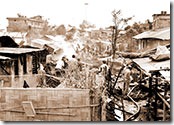: A new roadway from Aizawl to the far-flung, poor region has opened up the state's fertile interiors and has fostered a sense of vibrancy among villagers by giving rise to new enterprises. The broadening of the road has been under the $60 million World Bank-supported Mizoram State Roads Project.
The venerable Rev. Dr. C.L. Hminga recalls the arduous journey on foot, bus, and train, from his home in the remote Mizo hills to his school in Shillong, not too far north as the crow flies. While that was a long time ago, little had changed till the 1990s, with few motorable roads traversing these gentle uplands in the far north eastern corner of India.
Today, the good reverend has reason to be happy. The road from Mizoram's capital, Aizawl, to his hometown in Lunglei, the state's second major town, earlier a potholed, landslide-prone track, is now much broader, safer and smoother.
"The road has opened up Mizoram's far-flung and poor interior," says Rev. Dr. K. Thanzauva, a prominent church leader from Lunglei, near the Myanmar and Bangladesh borders.
"We now feel closer to the capital, and the lives of the villagers will improve."
Connectivity is crucial for a distant hill state like Mizoram. Although trucks and buses snake through the highlands, carrying supplies from the railhead in Assam, and flights arrive from Guwahati and Kolkata, the long and difficult transportation routes over mostly mountainous terrain continue to hamper trade and development.
Four-fifth of Mizoram's border is flanked by other nations, with the plains of Bangladesh falling away to the west, and Myanmar lying to the east. Geographically isolated from mainland India, Mizoram conducts virtually no trade with other Indian states, nor with neighboring countries. The loss of access to Chittagong Port following the partition of India in 1947 dealt a major blow to the region's economy. Now, the nearest accessible sea port is Kolkata in West Bengal, which involves a tedious 1700 kilometer long journey from Aizawl.
Equally important is the psychological isolation that results from poor connectivity. "You can fly here in one day," says Liansanga, Engineer-in-Chief and Secretary of the Mizoram Public Works Department (PWD), "but mentally we're still very far away."
Once sleepy villages come to life
With little scope for new rail, river or air connections, good roads are vital for Mizoram's development. Not surprisingly, the recent broadening and 'blacktopping' of the old Aizawl – Lunglei road has been widely welcomed. The new road has fostered a sense of vibrancy among once-sleepy villages and given rise to new enterprises, especially meaningful in a state where unemployment has long stalked the educated youth.
With almost ninety percent of the population dependent on the land for a living, perhaps the greatest impact has been on agriculture. "The biggest part is that we are now finding a market for our crops," says a beaming Kawldinga of Thenzawl village, echoing the words of others along the road.
Earlier, pack animals and men carried loads up mountain paths, and slippery slopes during fierce monsoon rains made transportation difficult. "We had no option but to barter our surplus with friends and neighbors. So we planted only one monsoon crop of rice and ginger. Now, we also grow a winter crop of carrots, beans, mustard and cabbage," he adds. Village women sell the produce along the road, with the more enterprising ones even journeying to Aizawl to catch the capital's lucrative morning market.
With the opening up of the state's fertile interior, the government has ambitious plans for the future. "We plan to improve our piggeries and poultry and market the produce outside the state for the first time," says P.C. Lalthanliana, Mizoram's Minister of State for Social Welfare and Local Administration.
New enterprises
New enterprises are springing up. Small restaurants have mushroomed. "Business is growing," says Vanlalchuangi, a housewife-turned eatery owner in Aibawk village, just 40 minutes out of Aizawl. Sensing the new business opportunities the road would bring, her family added an extra floor when they rebuilt their old timber house with the compensation money they received for the acquisition of land. The ground floor has since been turned into an airy restaurant and the family now lives above it.
The eateries provide a valuable service to travelers. "Earlier, you couldn't even get a cup of tea on the road," recalls Dr. R.L. Hnuni, a regular traveller.
With improved business prospects, land values have soared. In the weavers' hamlet of Thenzawl, for instance––considered the cultural heart of Mizoram––land prices have risen tenfold, climbing from Rs.10,000 an acre in 2005, to Rs.1 lac in 2010.

- Left: Village women can now sell their produce in Aizawl's lucrative morning market/ Right: Stalls selling local crafts are springing up along the road/ Photo credit: World Bank
Local crafts have benefited. Till recently, most of the traditional 'puans' (sarongs) woven by the women in almost every Thenzawl household were sold to the capital's middle-men. These now find a ready market in the village itself, with a number of new stalls displaying colorful wares opening up along the road.
With the motorable distance between Aizawl and Lunglei reduced from 235 km to 164 km, and driving conditions improved, the cost of transportation has fallen, saving time, saving diesel, and saving on repairs. Maxicabs now ply the route, and the sale of two wheelers and second hand cars is on the rise, providing the people a welcome mobility.
Education, health care, and growing ambitions of Mizo youth
An important benefit has been quicker access to health care. "Malaria and dysentery are common during the monsoon," says Lalrinmawia, President of the Aibawk Village Council, "and time is precious when someone is sick." The road has eased the health worries of the people as lives can now be saved by rushing the sick, as well as complicated pregnancy cases, to hospital in Aizawl.
The opening up of the interior has also fuelled the ambitions of Mizoram's youth. They can now attend good schools in the city, and football and hockey teams can participate in tournaments far afield, whether in Aizawl or in other states.
As faster speeds have led to more accidents, local women have banded together to raise awareness about road safety among drivers. Recently, the Mizoram Thunders, a 250 member club of 'bullet' motorcycle riders, roared down the road in a charity ride to warn the villagers about children playing on the road, and spreading rice out to dry there.
Unusual challenges
While the benefits are huge, constructing roads in these remote hills involves more than the usual challenges. Work can be undertaken for only 6 months a year, stopping altogether during the fierce monsoon rains.
Moreover, heavy construction equipment has to be brought in from outside, and machinery breakdowns and spare parts shortages cause unforeseen delays. Labor contracted from other states can create social tensions, quarries yielding suitable stone are difficult to locate, and outside contractors take time to understand the terrain. Nevertheless, says Ashok Kumar, the World Bank's team leader for the project, "The experience gained here will be very valuable for future Bank support to remote and inaccessible areas."
Local capacity has grown
Importantly, this $60 million World Bank-supported Mizoram State Roads Project has built the capacity of engineers from the state PWD – one of the country's youngest and smallest PWDs, created in 1972 when Mizoram became a Union Territory.
As the first major road project to be executed by them-till recently, the Border Roads Organization constructed the state's roads-it has provided local officials with new expertise and valuable exposure to engineers and contractors both from India and abroad.
"It took us time to learn, as the mode of supervision and contract management was new to us," says K. Lalsawmvela, the Project's Director – "But now we are ready to take up similar projects-and even bigger ones-on our own."
They soon plan to execute a new multimodal highway-the Kaladan Multimodal Project-that will develop a road and river route to Sittwe port in Myanmar, giving the state easier access to a sea port after more than half a century.
State project officials have also gained experience in addressing the complex social and environmental issues that often arise during road building.
To minimize the road's impact, tribal leaders, church groups, and others were regularly consulted, especially with regard to the Mizos' community ownership of land and their custom of 'jhumming'-a 'slash and burn' method of cultivation.
"You have to be open to people's opinions, and explain why things are being done the way they are," Lalsawmvela says.
Maintaining transparency has been important, especially in this highly literate state, and project documents were made available through public libraries. "This is the first time that we have seen such a transparent process," says Margaret Zohmingthangi, District Collector of Lunglei, although this can delay the work, she adds. "But in the end, everyone wants a road of such quality."
The inclusion of HIV prevention as part of the project assumed special significance in view of outside workers encountering Mizoram's more open society. "Earlier, we asked ourselves, what has an HIV program to do with a roads project," says Lalsawmvela, "but now we have seen its importance."
Pioneering a Road Maintenance Fund
Mizoram is also pioneering the establishment of a dedicated road fund to mobilize non-budgetary resources for road maintenance through a levy on the sale of diesel and petrol. The state assembly has recently passed the Mizoram Road Fund Rules 2010 and the government is in the process of implementing them. "This is a very bold initiative, especially for a small north eastern state like Mizoram," says Ashok Kumar.
"We can see the change," says R. Lalhmunmawia, the President of the Mizoram Road Transporters' Union. "If such roads were built in other parts of the state, our development would be much faster." No doubt, the improved techniques learnt by local engineers and contractors will bring long-term gains for the state's ongoing rural roads program, as well as for the more ambitious roads projects to come.
 Firemen and local residents try to douse the blaze at the 2nd Manipur Rifles battalion complex in Imphal on Monday.
Firemen and local residents try to douse the blaze at the 2nd Manipur Rifles battalion complex in Imphal on Monday. 

















